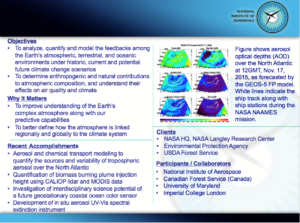Atmospheric Science
Objectives
- To analyze, quantify and model the feedbacks among the Earth’s atmospheric, terrestrial, and oceanic environments under historic, current and potential future climate change scenarios
- To determine anthropogenic and natural contributions to atmospheric composition, and understand their effects on air quality and climate
Why it Matters
- To improve understanding of the Earth’s complex atmosphere along with our predictive capabilities
- To better define how the atmosphere is linked regionally and globally to the climate system
Recent Accomplishments
- Aerosol and chemical transport modeling to quantify the sources and variability of tropospheric aerosol over the North Atlantic
- Quantification of biomass burning plume injection height using CALIOP lidar and MODIS data
- Investigation of interdisciplinary science potential of a future geostationary coastal ocean color sensor
- Development of in situ aerosol spectral extinction instrument
Clients
- NASA HQ, NASA Langley Research Center
- Environmental Protection Agency
- USDA Forest Service
Participants / Collaborators
- Canadian Forest Service (Canada)
- University of Maryland
- Imperial College London

